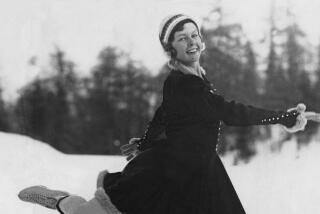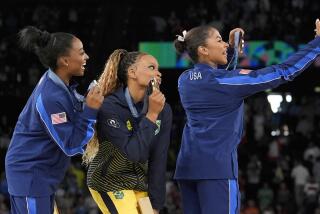Hockey: It’s All in the Family : Linda Geffner Comes to Play--She’s Not Just a Girl in a Boys’ Sport
- Share via
Linda Geffner is a rare combination: all girl, yet all hockey player. Not field hockey, mind you, a sport that convention says is more suitable for females. But ice hockey, replete with flashing skate blades, thudding body checks--and mucho machismo.
Geffner, a 16-year-old student at Crossroads School in Santa Monica, has been playing ice hockey for boys teams since she was 11. Though she is a native of a sunny clime--and therefore comes by her love of the sport in a somewhat unnatural fashion--she is apparently a natural on the ice.
The Beverlywood resident got her first taste of hockey from her parents, Susan and David.
Although her parents were born and raised in Los Angeles, they are die-hard hockey fans who used to religiously attend games of the Los Angeles Blades, a minor league team that preceded the arrival of the Los Angeles Kings of the National Hockey League. When the Kings came to town the Geffners transferred their allegiance to them.
Linda saw her first Kings game when she was a half-pint and discovered later that she not only loved the game but also wanted to play it. The trouble was that the sport in Los Angeles is played by teams composed mostly of boys.
That didn’t trouble her, however.
“When I discovered that I really wanted to play, I didn’t realize that they were boys and I was a girl,” she said. “I was just at an age (11) when it didn’t matter. I didn’t figure it was a boys sport, so I went ahead and started playing. Now I’m a little older, and it’s a little different.
“But then my hair was real short and half the people didn’t know I was a girl. My parents figured I would outgrow it. They used to whisper, with their hands over their mouths, ‘Give her a season and she’ll get over it.’
“I figured that was it--I’ll show them.”
Show them she did, sometimes to their dismay.
“My mom comes to games and is a little bit tentative. But after a while she enjoys it. My dad comes to every game.”
Susan Geffner confesses that watching Linda’s games is not always enjoyable. “It’s very difficult at this stage to watch her. There are certain kids on certain teams who are out to get her, and I get very emotional.”
Linda skates for the Marina City Sharks, whose home ice is the Culver Ice Rink. This is her second year with the Bantams group, for players 14 through 16 years old.
She said that she has seen other girls play for boys teams but that some tend to give up hockey as they get older. Girls who continue are asked to play an extra year with their age group, primarily because boys are getting bigger--and rougher. The Pee Wee group, she said, is for those 12 and 13, but she played in that age group for three years.
The theory behind the additional year requirement, she said, is that girls “won’t demolish as easily. But it doesn’t matter to me if you’re going to get hit or give a hit, which I do.”
That she does.
Brian Chapman, 14, a goalkeeper and teammate of Linda, said that a boy from an opposing team “might check her, but Linda takes it and checks right back.”
Carl Chapman, Brian’s father, coaches the Marina City Bantams and said that Linda is “a good team player.”
“I don’t think she’s at a disadvantage just because she’s a girl,” said the elder Chapman, who said he used to play high school hockey in Minnesota.
“It’s a rough sport, and a lot of kids are physical,” he said. “She has bigger kids to overcome, and I think that’s a real credit to her.”
He said that, since she is older than the boys she plays against, they sometimes “give her a good shot to shake her up so that she will theoretically be ineffective. But she comes back real strong and has made a lot of progress.”
Coach Chapman estimated that there are about 20 to 30 females in the Southern California Hockey Assn.’s age groups, from as young as 5 to as old as 55.
Some might say that these girls and women are risking serious injury by mixing it up with boys and men on the ice. But Chapman thinks that amateur hockey is a relatively safe sport for all players.
The players, he said, “wear a lot of protective gear, and they rarely take a direct hit as in football.”
He believes that Linda is safer than some of the other players. “(She) has been playing an awful long time, so she has the ability to protect herself. As we would say to an enemy on the ice, ‘Keep your head up (meaning that the opponent better watch out for himself).’
“She is a good player because she has skating ability, strength and because of her teamwork.”
She has had a couple of minor injuries but seems to have dismissed them with a shake of her ponytail, the hairdo she wears when she plays these days. She wears her hair that way so the boys can see that she’s a girl.
About a year ago, she said, she had a muscle tear in her right shoulder when a player slammed her into the boards.
“I had to wear a sling and was supposed to wear it for three weeks. But I got so tired of it that I just took it off after about a week. Sometimes I wake up and I can feel it (pain in her shoulder).”
She said that she acquired “kind of a knee injury” when she was doing a drill in hockey camp three years ago. Players had to drop to their knees on the ice, and her protective pad slipped and she smacked her knee against the ice.
“Every now and then it hurts,” she said. She has a knee brace for it, “which I don’t wear.” The injuries haven’t discouraged her from playing, and she wants to play intercollegiate hockey for Harvard’s women’s team. She goes to summer hockey camps in Montreal for instruction from professional players. She is at the Culver rink at least five days a week.
“I practice after a game once or twice a week,” she said. “I put in a little extra time because (the games) don’t give you enough time to stay in shape. You have to work out on your
own. I skate without my equipment; you can’t play if you can’t skate.”
She takes skating lessons from Gary Visconti, who finished fifth in figure skating in the 1968 Winter Olympics at Grenoble, France.
“He works me hard,” she said, putting her through drills for “agility, stroking, digging into the ice to make you go faster. He works me in everything. It just makes your game better by improving your skating.”
And Linda’s game is very good, and she also takes to coaching, Coach Chapman said.
“She has a good set of goals in mind, and she will probably get them. I like that in a player; it makes them easier to coach. I know she listens to me and that she’ll do (what he asks).”
But in competing with boys, he said, Linda does face difficulties.
“Her biggest problem--and I don’t care how long she’s been skating or how skilled she is--is that there is a certain intimidation factor from large boys. (She is 5 foot 5 inches and weighs 120 pounds but doesn’t look that heavy.) And she has to deal with that.
“As a team player, you’ve got to maintain your intensity level--but you also have to stay alive. That’s always at the back of your mind. No matter how courageous you are, that tends to be a factor in how you perform.”
Another problem, he said, is that “it is hard for a girl to have good upper-body strength, so her shot is not as hard as (that of) a boy her age. She tends to have a disadvantage in shooting, but she makes up for that by being a good assist player.
“You can always find someone who can shoot the puck but not someone with the ability to skate and pass.”
Linda has those hard-to-find talents, he said, and she has not surrendered any of her femininity to acquire them. “She still has a very ladylike quality off the ice. She’s not the tomboy type at all.”
She concedes that she is sometimes less than ladylike on the ice.
“If someone gets on me, I have a lightning temper, and I know when to hit somebody: when the referee is not looking. Of course, when you get hit, you try to make sure the referee is looking. That way you get a penalty (on the other player).”
She also uses another kind of weapon at times. “I have a big mouth,” she said, “and I kind of use it.”
She said she may not like women’s intercollegiate hockey as much as going against boys because “there is no hitting and it’s a lot different. But hey, you never know until you try it.”
Carl Chapman said he thinks that she will “adapt real well” to the women’s game and will be “a mile ahead of someone who hasn’t played in a boys league.” Brian Chapman, her goalie teammate, said he thinks that she can “handle herself” on the ice with the Sharks and can “take the roughness.”
“But if she was in trouble,” he said, “if someone tried to pick on her or she got into a fight, I would help her out.
“I consider her part of the team and one of the guys. She’s a pretty good hockey player--and she’s nice too.”
Absolutely, Brian.
More to Read
Go beyond the scoreboard
Get the latest on L.A.'s teams in the daily Sports Report newsletter.
You may occasionally receive promotional content from the Los Angeles Times.






